Updated on December 22, 2023 by Lou Mac
So you’ve decided to learn Spanish—yay!
You’ve done your research on how to learn Spanish on your own, you’ve set some goals, you’ve even set some habits and routines for yourself (well, maybe you haven’t, but I recommend it! Here’s how building habits will help you learn Spanish).
On your journey, there are lots of unfamiliar phrases that keep popping up: nouns, pronouns, verbs, verb conjugation…
You may remember that verbs are “action words,” but what on earth is Spanish verb conjugation?! Do I really need to learn it?
In this article you’ll learn:
- Exactly what verbs are, the different kinds of verbs and tenses
- All about how to “conjugate” them
- How you, as a beginner, can master them quickly and effectively
- Resources for further study
What is a Verb?
As mentioned earlier, you’ll probably remember from your school days that a verb is a “doing word” or an “action word.”
Words that come to mind are obvious “action” words like “jump” and “run,” but they are any sort of action—from sitting, to listening, to wondering.
By definition “a verb is word used to describe an action, state, or occurrence, and forming the main part of the predicate of a sentence”
Verbs make up a huge amount of our vocabulary, so it’s no surprise that in Spanish they do too!
What is Spanish Verb Conjugation and Why is it Important?

I still remember hearing the phrase “verb conjugation” and feeling overwhelmed—but while it may sound fancy, all it means is changing a verb to reflect a different person, number, tense or mood.
It tells you who is doing what, and when they are doing it.
You may not have heard of verb conjugation before if you haven’t studied a foreign language, especially because in English our verb conjugation is pretty subtle so you don’t realize we actually use it!
For example, consider how in English we say: “I eat’ and “she eats.”
The S on the end of “eat” is an example of conjugating the verb “to eat” in the third person. We wouldn’t say “she eat,” because that sounds strange to us, and nor would we say “I eats.”
Comparatively, Spanish verb conjugations are a lot more complex—for each subject, there is almost always a different way to conjugate the verb. For example, where in English we only have two ways of conjugating the verb “to eat” in the present tense, in Spanish they have six ways:
English: I eat, you eat, he/she eats, they eat, we eat
Spanish: yo como, tú comes, ella/él/usted come, ellas/ellos/ustedes comen, nosotras/nosotros comemos, vosotras/vosotros coméis
See how all the Spanish verbs share the same stem (com-) but have different endings?
Don’t let this put you off, you will learn them! It’s just good to be aware of what lies ahead.
If this is all new to you, you might benefit from downloading our free Beginner’s Guidebook to Self-Learning Spanish. It goes over the most important things for you to know as a beginner learning Spanish on your own, as well as tips and resources to get you started.
And now: why is Spanish verb conjugation so important?
A conjugated verb contains a lot of information in just one word, so it’s important you get them right so that you can convey the right information. If you get the conjugation wrong, you could change the meaning of the whole sentence!
You should worry, but also not worry too much—people will usually understand what you’re trying to say (only it would sound strange to them).
When I started learning Spanish I specifically remember coming across different conjugations on Duolingo and thinking “this is too much, I just won’t learn the conjugations, they can’t be that important.” 🙄 Now being fluent in Spanish, I can see how incredibly wrong I was!
Verb conjugations are extremely important and you must learn them if you want to speak Spanish. Trust me on this!
The Basics of Spanish Verbs and Tenses

The “Infinitive”: AR, ER and IR Verbs
Something you will see and hear often is “the infinitive.” This is the most basic form of a verb, with no inflection connecting it to a particular subject, tense or mood.
It gives you no information as to who is doing the action or when—it is the “naked” form of a verb, if you like.
In English, infinitives come with “to” in front of the action: to speak, to see, to write etc. In Spanish, infinitives end in either AR, ER or IR. For example:
- Hablar — to speak
- Ver — to see
- Escribir — to write
The infinitive is important because:
- You need it to reach the conjugated verb
- When you learn vocabulary, you will memorise the infinitive instead of individual conjugated verbs
- You often use the infinitive on it’s own, unconjugated!
Regular v Irregular Spanish Verbs
Just to make it a bit more fun, we have the concept of regular and irregular verbs. 🙊 While regular verbs are well behaved and comply with the normal patterns I’m about to show you, irregular verbs are just that—irregular.
They have different patterns of conjugation, meaning you’ll have to learn all of their conjugations individually!
Don’t worry though—while it takes a bit more study to learn the irregular Spanish verb conjugations, it’s not actually as much work as you may initially think. Some of the irregular verbs share the same patterns, which you will pick up on when you use them!
Stem Changing Verbs
The stem of a verb is what is left when you remove the infinitive ending (i.e when you remove the ‐ar, ‐er, or ‐ir).
When conjugating regular verbs, and even some irregular ones, the stem stays the same and the ending changes.
There are however some verbs called “stem changing verbs,” where the stem changes along with the ending!
There are some patterns you can learn around changing the stems, but don’t worry too much about it when you’re just starting out. In fact, I never studied them specifically: I just used irregular verbs in writing/conversation, and through that I unconsciously learned to identify when a verb needs it’s stem changed.
So while it’s good to be aware that they exist (hence why I have included it in this article), don’t focus too much on them.
Verb Tenses and Moods
Welcome to the world of verb classification!
I’ve been learning Spanish for years and the grammatical terms for verb classification still confuse me. Luckily though, it doesn’t actually matter if you know the grammatical name for them!
You definitely do not need to know the name of every single way a verb can be used—what matters is just that we understand when to use them. However if you are the type who loves a grammar deep-dive, here is a good article which explains them.
Essentially, there are two main things you need to know about verb classification:
- Tense: Refers to the time when the action of the verb occurs.
- Mood: A category distinguishing verb tenses. There are three moods in Spanish.
- Indicative mood: The most common mood, used to relate facts and objective statements.
- Subjunctive mood: Used to express reactions and feelings (subjective thoughts). It is used more commonly in Spanish than in English.
- Imperative mood: Used to give direct orders or commands.
Now that the classification is out of the way (phew), we can move on to the main tenses/moods that you’ll want to learn on your Spanish journey.
I do not recommend you focus on learning these as a beginner—they can wait until you’ve advanced a bit first!
However, it might be good to see a brief overview of what is in store for you:
- Present: Used to talk about things in the present.
- Preterite: A past tense where the action had a definite beginning and definite end.
- Past imperfect: A past tense where the action did not have a definite end, or happened frequently. The English equivalent would be like saying “used to…”.
- Future: Also a rather obvious one – used when talking about things in the future.
- Conditional: Used to describe what someone would do or what would happen in the future. Essentially the equivalent to saying “would” in English.
- Past participle: A verb form that can function as part of a “perfect tense” when used in conjunction with haber (to have). It sounds confusing, but I try to think of the English equivalent—in English, past participles are verb forms that follow have/has. E.g been, seen, written, gone.
- Progressive: Used with something in the process of happening. In English the equivalent would be the ‘-ing’ form.
- Present perfect: A past event that has present consequences.
- Present subjunctive: Present tense in subjunctive mood.
- Imperfect subjunctive: Past tense in subjunctive mood.
- Imperative: Used to give direct orders or commands.
As a beginner, just start with learning the following three tenses, which we will be discussing more in depth later in the article:
- Present tense (indicative)
- Preterite (past) tense
- Past imperfect tense (indicative)
Four Steps to Spanish Verb Conjugation

Finally we’re at the best bit: how to actually conjugate the verbs I’ve been waffling on about for so long!
What you’ll need for this
- The infinitive of the verb you want to conjugate
- The appropriate conjugation table (you will eventually memorise it well enough that you don’t need to refer to the table!)
Spanish Verb Conjugation Tables
A verb conjugation table is a table which clearly presents the different endings for the three different verb types (-ar, -er, and -ir) and the corresponding subject (I, you, she etc.).
Note: the feminine versions of ellos, nosotros and vosotros (ellas, nosotras and vosotras) have the same conjugation as the masculine pronouns, I just left them out so the table is easier to read.
Below is an example of a conjugation table for the present tense:
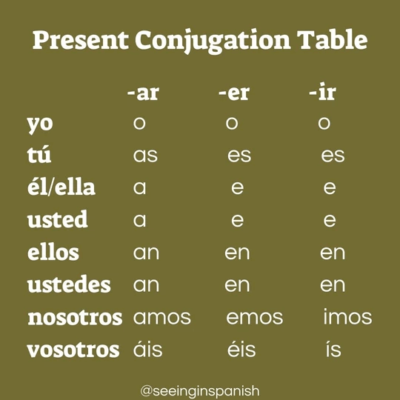
- Find the infinitive (the most basic form of the verb) that you want to use in Spanish.
- Remove the ending (the -ar, -er, or -ir) so you’re left with the stem.
- Figure out the subject (who you’re talking about, e.g yourself, a group of people etc).
- Add the appropriate ending from the conjugation table.
For example, say I want to say “I speak English” in Spanish:
- The infinitive I’ll use will be hablar (to speak)
- Remove the -ar from hablar. This leaves us with the stem habl-
- I’m talking about myself—yo
- After consulting the conjugation table, I can see that the appropriate ending is ‘o’. Habl + o = hablo! There we have it: hablo inglés = I speak English
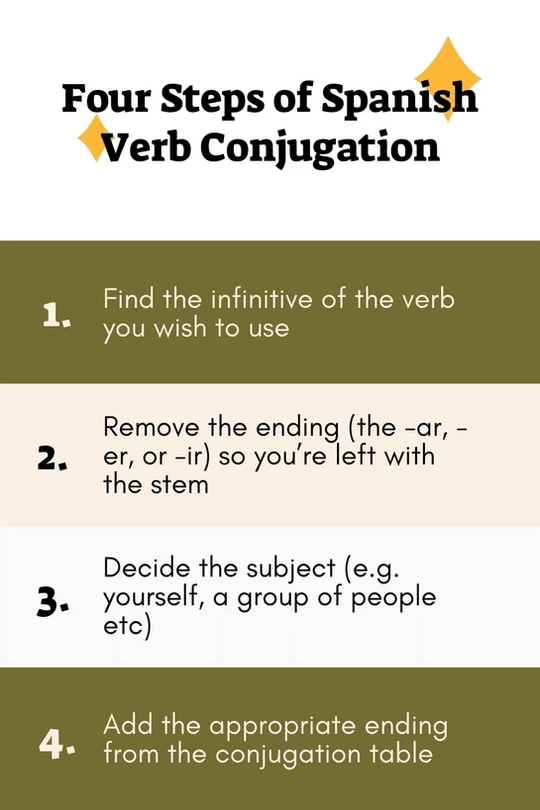
What to Focus On as a Beginner
As mentioned earlier, there are three main tenses that (in my opinion) you should focus on above all others to begin with.
These tenses will come up the most in the beginning, and sticking to mastering them will be much more effective than trying to learn every single tense/mood from the get go.
By memorising the conjugation tables, it will mean that you can conjugate any (regular) verb that you come across, even if it’s your first time hearing it!
Spanish Present Tense Conjugation
The present tense, used to speak about the present, is the very first conjugation you should learn. Without it you will have a very hard time using verbs and communicating what you want to say!

Examples of Present Tense Conjugation
Using this conjugation table, we can conjugate the following Spanish verbs in the present tense.

Spanish Preterite Conjugation
The preterite is a form of past tense. It is used to speak about events actions/events that:
- Were completed at a certain point in the past
- That went on for a certain amount of time
- Are seen as completed
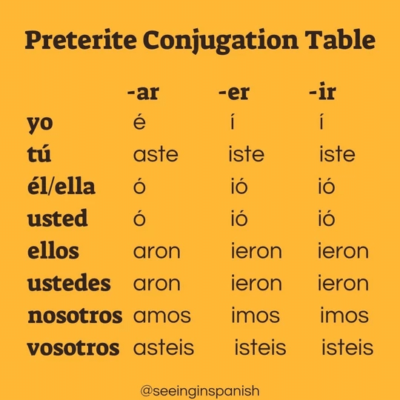
Examples of Preterite Tense Conjugation
Using this conjugation table, we can conjugate the following Spanish verbs in the preterite tense.
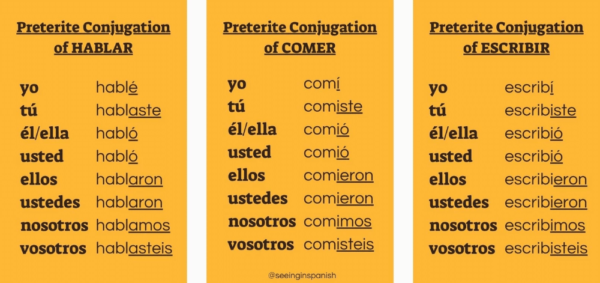
Spanish Past Imperfect Conjugation
The past imperfect is another form of past tense. It is to speak about events actions/events that:
- Did not have a definite beginning or a definite end.
- Happened often or habitually.
- Are not seen as completed.
It is often compared to the phrase “used to” in English (e.g. I used to walk to work).
Here is a good article on the differences between preterite and past imperfect if you’re unsure.
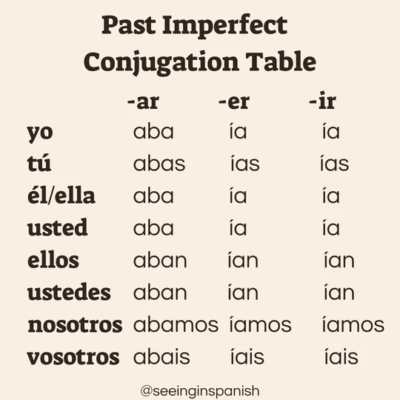
Examples of Past Imperfect Tense Conjugation
Using this conjugation table, we can conjugate the following Spanish verbs in the past imperfect tense.
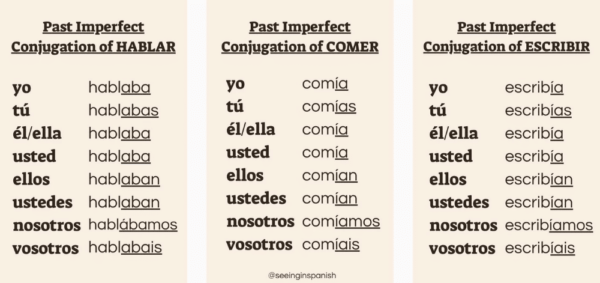
Common Verbs You Should Learn
Our next step is to learn different verbs so that we can actually apply what we’ve learnt!
People often try to memorise as many verbs as they can, however this is very time consuming and will slow down your progress as a beginner.
The more effective route is focusing purely on verbs which you will use the most.
This type of learning applies the 80/20 principle: the idea that 80% of results are produced by only 20% of an action.
In this case, 80% of what you’ll be able to say will come from learning just 20% of Spanish verbs—the majority being the most common verbs in the lists below!
Interestingly, the most common verbs (overall) are mostly irregular, so we have given you more irregular than regular verbs to learn! For a combined list of the most common verbs overall (both regular and irregular), check out this blog post on the most important vocabulary for beginners.
Most Common Regular Verbs in Spanish
- Pasar — to pass, to spend (time), to happen
- Quedar — to stay, to remain
- Hablar — to speak
- Llevar — to carry, to bring
- Dejar — to leave, to let
- Llamar — to call, to name
- Tomar — to take, to drink
- Vivir — to live
- Tratar — to treat, to handle
- Esperar — to wait for, to hope
Most Common Irregular Verbs in Spanish
Unfortunately, an awful lot of common verbs are actually irregular verbs—they don’t always follow the same conjugation patterns as regular verbs.
You’ll need to learn them individually, however you may see some patterns emerging amongst these irregular verbs which may help you to remember them! A quick Google search will bring up these conjugations for you.
- Ser — to be
- Estar — to be
- Haber — to have, to be
- Tener — to have
- Hacer — to do, to make
- Ir — to go
- Poder — to be able
- Decir — to say
- Ver — to see
- Querer — to want
- Creer — to believe
- Llegar — to arrive
- Pensar — to think
- Conocer — to know, to get to know
- Saber — to know
Practice Spanish Verb Conjuation

By now you’re probably wondering how you are going to learn all this.
Fair thought!
Let me start by saying that it may take some time to learn it all, but if you take it little bits at a time it won’t overwhelm you.
From language learner to language learner, here are some bits of advice for actually studying and memorizing these verbs and conjugation tables, as well as some resources to further your understanding.
Flashcards
Back to basics! Having understood the concept of Spanish verb conjugation, the challenge now is essentially to memorize the tables and different verb meanings.
Flash cards can be good for this if that’s what you enjoy—get a friend or family member to help you out!
Another idea, the one I prefer, is to use some sort of flashcard app such as Anki.
Draw Conjugation Tables From Memory
This is pretty self-explanatory—draw out the verb conjugation table (for whatever tense you’re learning) from memory to help cement it in your brain.
When speaking Spanish you’ll need to recollect the conjugations within a matter of seconds, so the faster you can remember everything, the better!
Write Out Verb Conjugations From Memory
Say for example you wanted to use the verb querer (to want) to practice Spanish verb conjugation.
Pick a tense, then write that verb out in the conjugated form for each subject. Repeat with different verbs or different tenses!
Start Chatting with People!
Real life practice is the best way to learn verbs and their conjugations.
Start out over messaging apps and websites, as there will be less pressure and you’ll have more time to look things up.
HelloTalk and Tandem are both good apps for this!
Finally, good luck!
Remember that learning Spanish is a process, and while it may seem too much at times, just take a deep breath and know that it will be worth it in the end.

